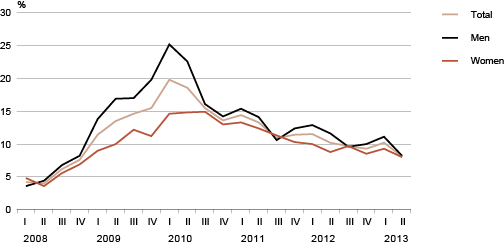In the 2nd quarter unemployment decreased
According to the data of the Labour Force Survey, the unemployment rate in the 2nd quarter was lower than in the previous quarter as well as in the same quarter of the previous year (when it was 10.2% in both cases). Unemployment has been in decline since 2010. The estimated number of unemployed persons was 57,000 in the 2nd quarter, which is 14,000 persons less compared to the same quarter of the previous year.
In the 2nd quarter, unemployment decreased more among men than among women, both compared to the previous quarter and the same quarter of the previous year. Unemployment is usually higher among men, but in the 2nd quarter the unemployment rates for women and men reached a similar level.
The number of the long-term unemployed (i.e. people who had been looking for a job for one year or longer) declined remarkably (by 9,000) in the 2nd quarter compared to the same quarter of the previous year, and totalled 28,000. The long-term unemployment rate was 3.9% in the 2nd quarter and declined primarily due to the diminishing number of the very long-term unemployed (unemployed for two years or more). The number of the short-term unemployed (i.e. people who had been looking for a job for under a year) declined by 5,000 compared to the same quarter of the previous year.
By age group, unemployment decreased more among young and middle-aged persons, and less among the elderly. The youth unemployment rate (i.e. the share of unemployed persons aged 15–24 among the labour force of the same age) was 16.1% in the 2nd quarter, which is notably smaller compared to the previous quarter as well as the same quarter of the previous year (when the youth unemployment rate was 23.1% and 24.4%, respectively). The number of the young unemployed decreased by a third in a year. As the unemployment rate is calculated as a share of those young people who are economically active, but most of this age group is still studying, the share of the unemployed among all young people aged 15–24 was 6.5%.
In the 2nd quarter, the employment rate of the population aged 15–74 was 63.0%. It increased compared to the previous quarter as well as the same quarter of the previous year (when the employment rate was 60.8% and 60.9%, respectively). The estimated number of employed persons was 645,000. The rise in employment was due to the decreasing number of the unemployed as well as economically inactive persons (not working nor looking for a job).
The share of economically inactive persons (students, retired persons, homemakers, discouraged persons, etc.) in the population aged 15–74 decreased. It was 31% in the 2nd quarter, i.e. 322,000 persons, which is 8,000 persons less than in the previous quarter. Among inactive persons, the number of persons inactive due to health problems decreased the most. The number of discouraged persons (i.e. persons who have stopped seeking a job) increased slightly – they numbered 9,000 in the 2nd quarter.
In the calculation of the estimates for 2012 and 2013, the estimated number of population published by Statistics Estonia as of 1 January 2012 has been used to ensure the comparability in time series; this population figure has not been adjusted with the data of the 2011 Population and Housing Census. The Labour Force Survey data for 2000–2013 will be adjusted after the revision of the population number during the years between the two censuses and will be published in the 1st quarter of 2014.
Unemployment rate is the share of the unemployed in the labour force (the sum of the employed and unemployed persons). Long-term unemployment rate is the share of people who have been unemployed for a year or longer among the total labour force. Employment rate is the share of the employed in the working-age population (aged 15–74). The estimates are based on the data of the Labour Force Survey. Statistics Estonia has been conducting the Labour Force Survey since 1995 and every quarter 5,000 persons participate in the survey. The Labour Force Survey is carried out by statistical organisations in all the European Union Member States on the basis of a harmonised methodology.
Unemployment rate by sex, 1st quarter 2008 – 2nd quarter 2013
